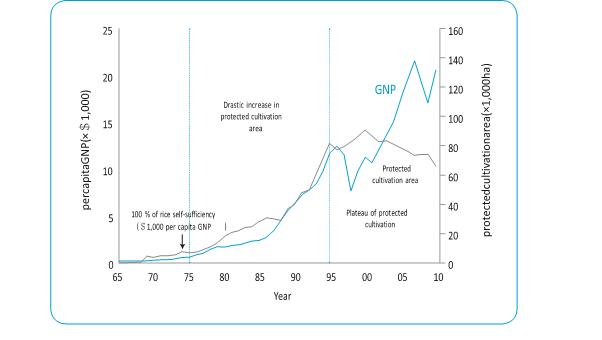‘White Revolution’ as the period of modernization of structure, material and technology for greenhouse to achieve the rapid expansion of protected cultivation area and stable supply of vegetables, from 1970s to 1990s. Although there has been an abundance of discussion to define (or issues related to the achievement in the process of) ‘White Revolution’ in Korean agriculture.
In Korea, self-sufficiency of rice was achieved in mid-1970sok-Dong Kim ect. 2012. The Green Revolution in Korea: Development and Dissemination of Tongil-type Rice Varieties. 2011 Modularization of Korea’s Development Experience.View and greenhouse cultivation of vegetables using plastic film-covered greenhouses rapidly expanded. This phenomenon is referred to as ‘White Revolution.’ Greenhouse cultivation of agricultural crops is a complex industry requiring technologies and materials from a variety of fields. The structures of greenhouses require construction technologies and internal and external covers require plastic films which are petrochemical products. Technologies from other fields such as light transparency and heating preservation of such materials as well as thermodynamic interpretation of atmosphere within the greenhouses and knowledge about weather of the limited spaces are all comprehensively involved in the protected horticulture industry.
Also, for the expansion of vegetables production through greenhouse cultivation, consumer income increase is a prerequisite for an active demand market. Moreover, infrastructure industries such as production of agricultural plastics for establishment of greenhouses and steel industry for the structures are needed to support the industry. Transportation of the products must be facilitated as well. In Korea, protected horticulture industry began along with the self-sufficiency of rice, and when the GNP rose above $500, the areas for greenhouse cultivation rapidly expanded. There have been lots of discussions in defining ‘White Revolution’ in Korean agriculture. However, most people agree that the term refers to the phenomenon that increase in protected cultivation area were positively related to increase in the national income from mid 1970s to mid 1990s. It was very rare to grow horticultural crops in greenhouses before 1970s, but vegetable cultivation in the field started to be replaced by that in greenhouse due to mass production of polyethylene film (PE) in Korea after the Ulsan Petrochemical Complex was constructed in 1970, in the second five-year NEDP (NEDP). It was an excellent national development strategy to plan the domestic production of plastic films for use in agriculture in 1966 when per capita GNP was only $125 in Korea where no crude oil is produced. Korea’s per capita GNP was only $105 in 1965; however, due to rapid economic growth, it was $602 in 1975, six-fold increase for ten years. In this period, annual economic growth rates were 7.8%, 9.7% and 10.1% during the first, second and third NEDP, respectively. Protected cultivation of vegetables was rapidly expanded after domestic production of plastic films in 1970. The cultivated area of vegetables under protected cultivation was 6,600ha in 1975 when per capita GNP was $602 and this increased up to 81,600ha in 1995 when per capita GNP was $11,432. As shown in figure, the increase in protected cultivation area was directly proportional to the increase in per capita GNP. Interestingly, such direct proportion was not observed after 1995. Even after the Asian financial crisis in 1997 when national income was largely reduced, protected cultivation area did not fluctuate. In the first half of 1990s, both per capita GNP ($11,432) and protected cultivation area (81,600ha) were the highest in 1995 but the correlation did not continue after 1995. Per capita GNP was highest in 1996 and rapidly reduced by $7,355 in 1997 due to the Asian financial crisis that made Korea draw financial support from International Monetary Fund (IMF) and then increased continuously until 2007 by $20, 045; however, protected cultivation area did not increase since 1995. Rather, protected cultivation area slightly decreased and small, single span greenhouses were replaced by bigger, multi span greenhouses (capital and technology intensive). Around the time that GNP reached $1,000 - $2,000, the population in rural areas decreased and rapid urbanization took place. With the population of rural community aging, more women engaging in agriculture and increased consumer demand for high quality vegetables, various technologies for mechanization of agricultural industry came to be required.
[Relationship between per Capita GNP and Protected Cultivation Area in Korea]

First, year-round production of agricultural products was achieved through ‘White Revolution’ with the increase in protected cultivation area that are positively correlated with increase in the national income, which make possible for consumers to buy agricultural products regardless of the growing season. Second, due to seamless supply chain of vegetables, Korea is now one of the biggest consumers of vegetables per capita. Third, most vegetable fruits such as watermelon, strawberry, oriental melon, and tomato, which were cultivated in open field before, are now cultivated in greenhouses. Last, but not least, greenhouses framed with bamboo were replaced by those with steel pipe and this made it possible to build multi-span greenhouses; as a result, Korea owns one of the best technology in protected cultivation.